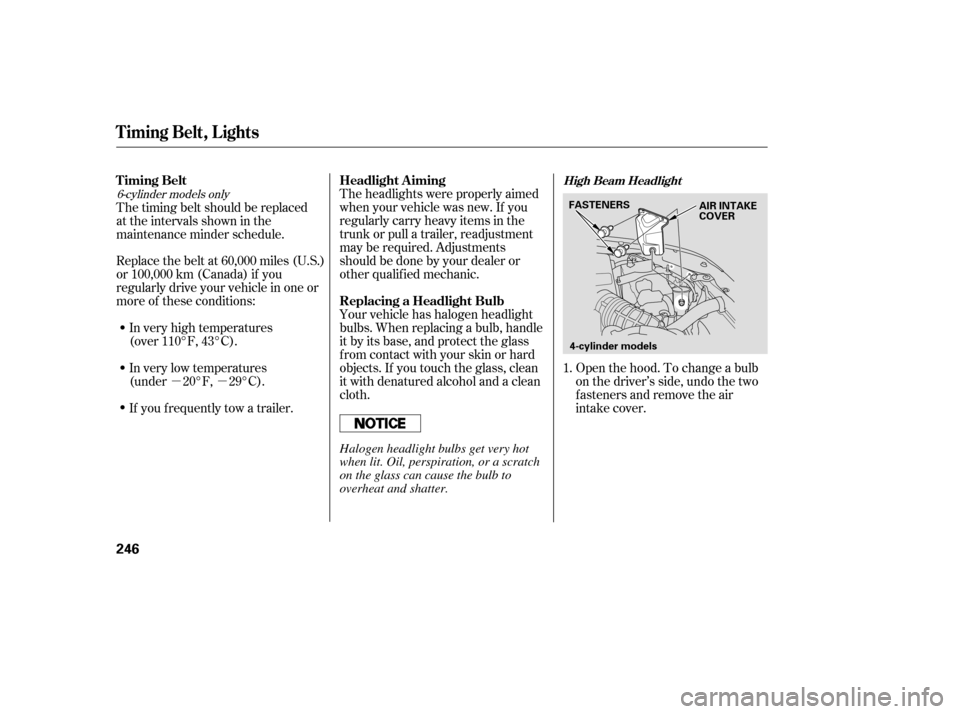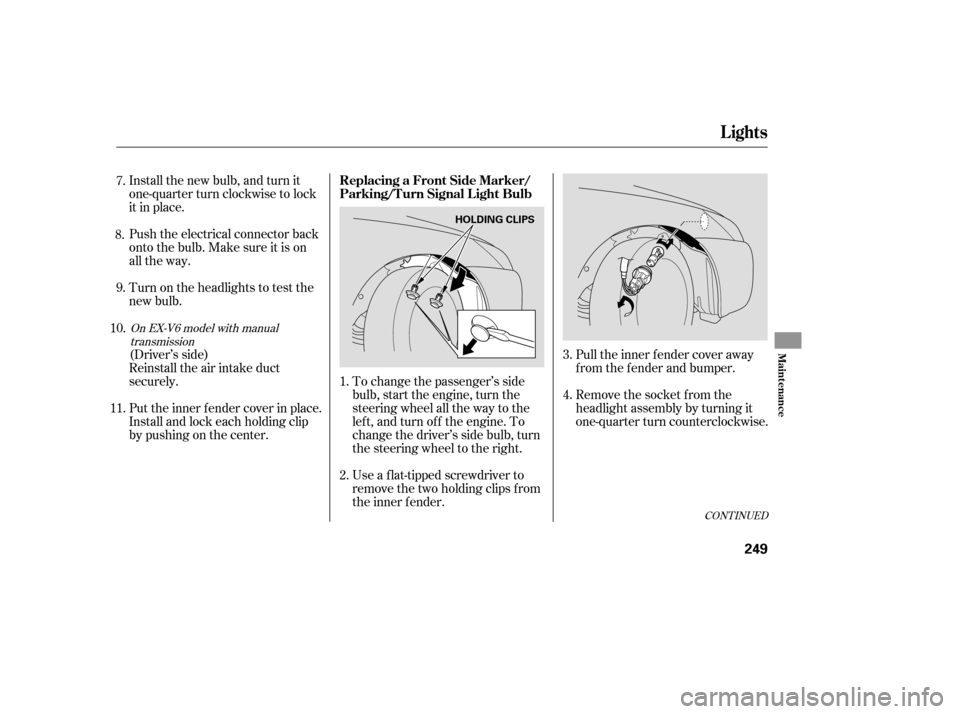Page 228 of 319

�Ì�µ
�µ�µ
�µ
�µ �µ
U.S. Vehicles:
According to state and federal
regulations, failure to perform
maintenance on the items m arked
with will not void your emissions
warranties. However, all
maintenance servi ces should be
performed in accordance with the
intervals indicated by the
information display. Youshouldcheckthefollowing
items at the specified intervals. If
you are unsure of how to perform
any check, turn to the appropriate
page listed.
Engine oil level Check every
time you fill the fuel tank. See
page .
Engine coolant level Check the
radiator reserve tank every time
you fill the fuel tank. See page .
Automatic transmission Check
the fluid level monthly. See page
.
Brakes Check the fluid level
monthly. See page .
Tires Check the tire pressure
monthly. Examine the tread for
wear and foreign objects. See page
. Lights
Check the operation of
the headlights, parking lights,
taillights, high-mount brake light,
and licen se plate lights monthly.
See page .
188 189
239 244
256 246
Maintenance Minder
Maintenance, replacement, or
repair of emissions control
devices and systems may be done
by any automotive repair
establishment or individual using
parts that are ‘‘certif ied’’ to EPA
standards.
Owner’s Maintenance Checks
226
�����—�����—�����y�
���������
���y���
�(���%�������y���������y
Page 248 of 319

�µ�µTheheadlightswereproperlyaimed
when your vehicle was new. If you
regularly carry heavy items in the
trunk or pull a trailer, readjustment
may be required. Adjustments
should be done by your dealer or
other qualif ied mechanic.
Open the hood. To change a bulb
on the driver’s side, undo the two
f asteners and remove the air
intake cover.
Your vehicle has halogen headlight
bulbs. When replacing a bulb, handle
it by its base, and protect the glass
f rom contact with your skin or hard
objects. If you touch the glass, clean
it with denatured alcohol and a clean
cloth.
If you f requently tow a trailer.
Replace the belt at 60,000 miles (U.S.)
or 100,000 km (Canada) if you
regularly drive your vehicle in one or
more of these conditions: The timing belt should be replaced
at the intervals shown in the
maintenance minder schedule.
In very high temperatures
(over 110°F, 43°C).
In very low temperatures
(under 20°F, 29°C). 1.
6-cylinder models only
Timing Belt, Lights
Headlight A iming
Replacing a Headlight Bulb
Timing BeltHigh Beam Headlight
246
FASTENERS
AIR INTAKE
COVER
4-cylinder models
Halogen headlight bulbs get very hot
when lit. Oil, perspiration, or a scratch
on the glass can cause the bulb to
overheat and shatter.
�����—�����—�����y�
�������������y���
�(���%�������y���������y
Page 249 of 319
Remove the electrical connector
f rom the bulb by squeezing the
connector to unlock the tab, then
slide the connector of f the bulb.
Remove the bulb by turning it
approximately one-quarter turn
counterclockwise.
Install the new bulb, and turn it
one-quarter turn clockwise to lock
it in place.Reinstall the air intake cover.
Reinstall the two fasteners and
secure them by pushing on the
heads until they lock. (Driver’s side) Turn on the headlights to test the
new bulb. Push the electrical connector back
onto the bulb. Make sure it is on
all the way.
3. 2.
4. 5.
6.
7.
Lights
Maint enance
247
6-cylinder models
FASTENERS
4-cylinder models 6-cylinder modelsTAB BULB
TABBULB
AIR INTAKE
COVER
�����—�����—�����y�
�������������y���
�(���%�������y���������y
Page 251 of 319

Pull the inner f ender cover away
f rom the f ender and bumper.
Remove the socket from the
headlight assembly by turning it
one-quarter turn counterclockwise.
Install the new bulb, and turn it
one-quarter turn clockwise to lock
it in place.
Push the electrical connector back
onto the bulb. Make sure it is on
all the way.
Turn on the headlights to test the
new bulb.
Reinstall the air intake duct
securely. (Driver’s side)
Put the inner f ender cover in place.
Install and lock each holding clip
bypushingonthecenter.
To change the passenger’s side
bulb, start the engine, turn the
steering wheel all the way to the
lef t, and turn of f the engine. To
change the driver’s side bulb, turn
the steering wheel to the right.
Use a f lat-tipped screwdriver to
remove the two holding clips f rom
the inner f ender.
1.
3.
2. 4.
9. 7.
8.
11. 10.
CONT INUED
On EX-V6 model with manual transmission
Replacing a Front Side Marker/
Parking/Turn Signal Light Bulb
Lights
Maint enance
249
HOLDING CLIPS
�����—�����—�����y�
�����������
�y���
�(���%�������y���������y
Page 272 of 319

Store the jack in its holder. Turn
the jack’s end bracket to lock it in
place. Replace the cover. Store the
tools.
Store the wheel cover or center
cap in the trunk. Make sure it does
not get scratched or damaged.
Lower the trunk floor, then close
the trunk lid. Di
agnosing why the engine won’t
start falls into two areas, depending
on what you hear when you turn the
ignition switch to the START (III)
position: Wh
en you turn the ignition switch to
the START (III) position, you do not
hear the normal noise of the engine
trying to start. You may hear a
clicking sound or series of clicks, or
nothing at all.
Check these things:
You
hear nothing, or almost
nothing. The engine’s starter
motor does not operate at all, or
operates very slowly.
You can hear the starter motor
operating normally, or the starter
motor sounds like it is spinning
faster than normal, but the engine
does not start up and run.
Turn the ignition switch to the ON
(II) position. Turn on the
headlights, and check their
brightness. If the headlights are
very dim or do not come on at all,
the battery is discharged. See on page .
Check the transmission interlock.
If you have a manual transmission,
the clutch pedal must be pushed
all the way to the f loor or the
starter will not operate. With an
automatic transmission, it must be
in Park or neutral.
20.
21. 22.
272
If the Engine Won’t Start
Nothing Happens or the Starter
Motor Operates Very Slowly
Jump Starting
Changing a Flat Tire, If the Engine Won’t Start
270
Loose items can fly around the
interior in a crash and could
seriously injure the occupants.
Store the wheel, jack, and tools
securely before driving.
�����—�����—�����y�
������
������y���
�(���%�������y���������y
Page 273 of 319

Ifyoufindnothingwrong,youwill
need a qualified technician to find
the problem. Seeon page .
There may be an electrical
problem, such as no power to the
fuel pump. Check all the fuses
(see page ). Do you have fuel? Check the fuel
gauge; the low fuel indicator m ay
not be working. Are you using a properly coded
key? An improperly coded key will
cause the immobilizer system
indicator in the instrument panel
to blink rapidly (see page ).
In this case, the starter motor’s
speed sounds normal, or even faster
than normal, when you turn the
ignition switch to the START (III)
position, but the engine does not run.
Are you using the proper starting
procedure? Refer to on page .
Turn the ignition switch to the
START (III) position. If the
headlights do not dim, check the
condition of the fuses. If the fuses
areOK,thereisprobably
something wrong with the
electrical circuit for the ignition
switch or starter motor. You will
need a qualified technician to
determine the problem (see
on page ).
If the headlights dim noticeably or
go out when you try to start the
engine, either the battery is
discharged or the connections are
corroded. Check the condition of the
battery and terminal connections
(see page ). You can then try
jump starting the vehicle from a
booster battery (see page ). 59
199
280 285
285
272
260
If theEngineWon’tStart
Emergency
Towing
T he Starter Operates Normally
Starting the
Engine
Emergency T owing
T aking Care of t he Unexpect ed
271
�����—�����—�����y�
������
������y���
�(���%�������y���������y
Page 282 of 319

The under-hood fuse box is on the
driver’s side. To open it, push the
tabs as shown. If
something electrical in your
vehicle stops working, the first thing
youshouldcheckforisablownfuse.
Determine from the chart on pages
and , or the diagram on the
f use box lid, which f use or f uses
control that device. Check those
f uses f irst, but check all the f uses
bef ore deciding that a blown f use is
the cause. Replace any blown f uses,
and check if the device works.
Turn the ignition switch to the
LOCK (0) position. Make sure the
headlights and all other
accessories are of f .
The interior f use box is on the
driver’s lower lef t side. To remove
the f use box lid, put your f inger in
the notch on the lid, and pull it
upward slightly, then pull it toward
you and take it out of its hinges. The vehicle’s f uses are contained in
two f use boxes.
Remove the cover f rom the f use
box.
1.
2. 283 284
Checking and Replacing Fuses
Fuses
280
INTERIOR
UNDER-HOOD
TAB
NOTCH
�����—�����—�����y�
���������
���y���
�(���%�������y���������y
Page 293 of 319

�µ
�µ
�µ
�µ
�µ
�µ
�µ
�µ
�µ
�µ
�µ
�µ
�µ
�µ
�Î �Î �Î
�Î
�Î
�Î�Î
�Î
�Î
�Î
�Î
�Î
�Î
�Î
Specifications (4-cylinder Models)
Technical Inf ormat ion
291
Engine
Lights
Battery
Fuses Alignment
Tires
12
V 24/2.2 CP
12
V
12 V 60
W (HB3)
51 W (HB4)
12 V 21 W 3.43
x 3.90 in (87.0 x 99.0 mm)
144 cu-in (2,354 cm
)
9.7 : 1
Type
BorexStroke
Displacement
Compression
ratio
Spark plugs
Headlights
Front
turn signal/parking/side
marker lights
Rear turn signal lights
Back-up lights
License plate lights
Ceiling light
Trunk light
Door courtesy lights
Vanity mirror lights
Spotlights 12
V 18 W
12 V 3 CP
12 V 8 W
12 V 5 W
12 V 2 CP
12 V 1.1 W
12 V 8 W
Capacity 12 V 38 AH/5 HR
12 V 47 AH/20 HR
Interior
Under-hood Water
cooled 4-stroke DOHC i-VTEC
4-cylinder gasoline engine
See page 284 or the fuse label
attached to the inside of the fuse
box lid.
See page 283 or the fuse box
cover.
60 psi (420 kPa , 4.2 kgf/cm
)
29 psi (200 kPa , 2.0 kgf/cm)
30 psi (210 kPa , 2.1 kgf/cm)
30 psi (210 kPa , 2.1 kgf/cm)
32 psi (220 kPa , 2.2 kgf/cm)
T135/90D15 100M P205/60R16 91V
P205/65R15 92H
Toe-in
Camber
Caster
Size
Pressure
3°15’
1°
0°
0.08 in (2.0 mm) 0.00 in (0.0 mm)
NGK:
DENSO:
SKJ20DRM13 SKJ20DRM11
IZFR6K13
IZFR6K11
Front
Rear
Front
Rear
Front
High
Low
Front/Rear
Spare
Front
Rear
Spare
4 : Canadian LX models 2 : Californian models with automatic transmission 1 : All models except Californian models with automatic transmission
3 : All models except Canadian LX
3
4 3
4
3
4
1
2
1
2
�����—�����—�����y�
�������������y���
�(���%�������y���������y